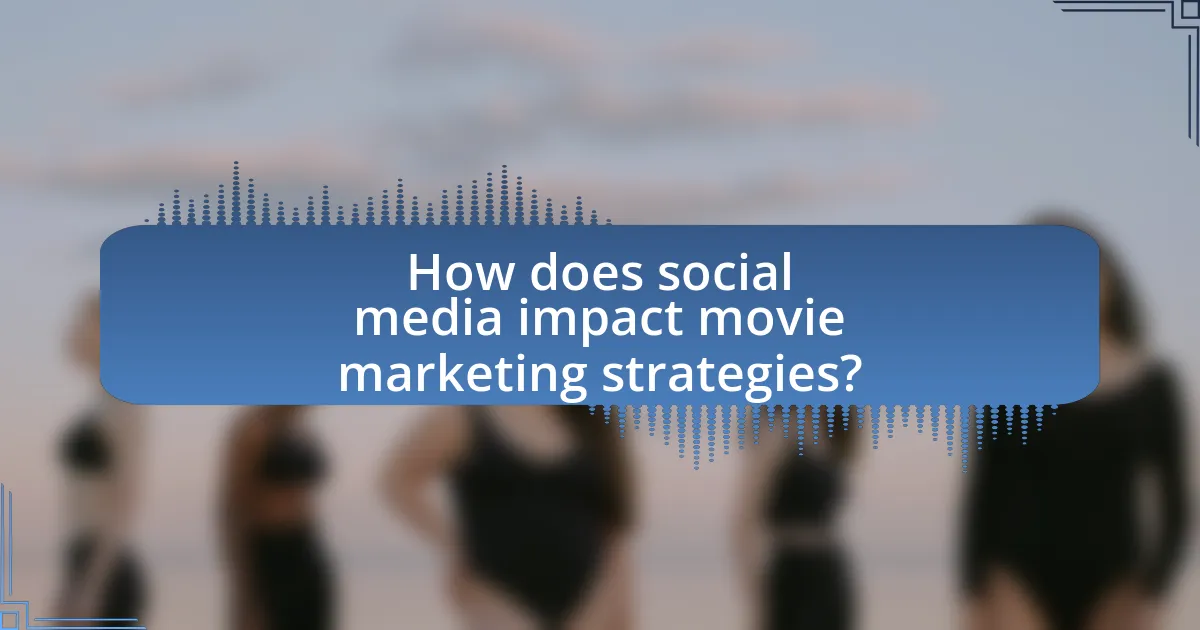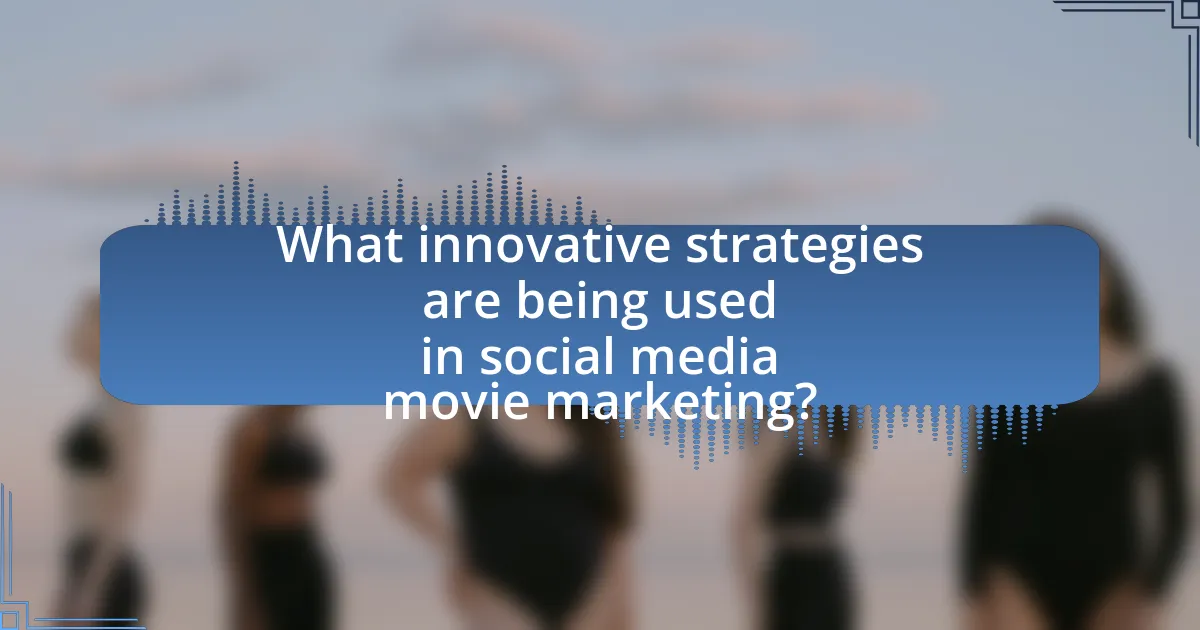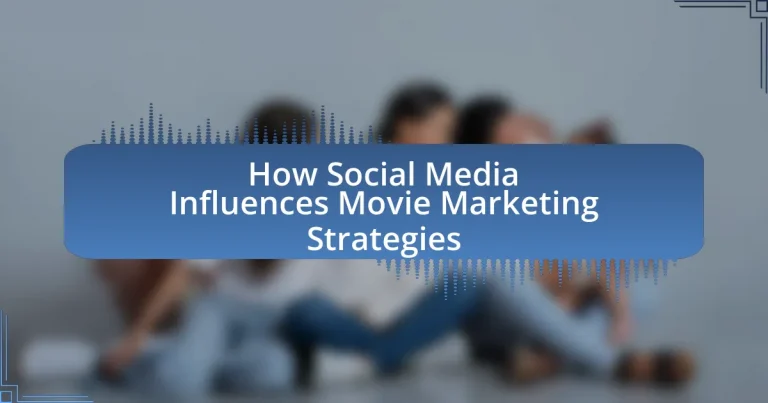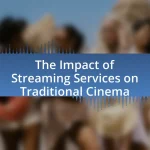The article examines how social media significantly influences movie marketing strategies, highlighting its role in audience engagement and targeted advertising. Key platforms such as Facebook, Instagram, Twitter, TikTok, and YouTube are explored for their unique features and demographic targeting capabilities. The article discusses the importance of user-generated content, influencer partnerships, and innovative marketing strategies, while also addressing challenges such as negative feedback and algorithm changes. Additionally, it outlines best practices for studios to create cohesive brand messages and measure the effectiveness of their social media campaigns, emphasizing the evolving landscape of film marketing in the digital age.

How does social media impact movie marketing strategies?
Social media significantly impacts movie marketing strategies by enabling direct engagement with audiences and facilitating targeted advertising. Platforms like Facebook, Instagram, and Twitter allow filmmakers to create buzz through trailers, behind-the-scenes content, and interactive campaigns, reaching millions instantly. For instance, the marketing campaign for “Deadpool” utilized social media to generate excitement, resulting in a $132 million opening weekend, largely attributed to its viral marketing approach. Additionally, social media analytics provide insights into audience preferences, allowing for more effective targeting and content customization, which enhances overall marketing effectiveness.
What are the key social media platforms used in movie marketing?
The key social media platforms used in movie marketing are Facebook, Instagram, Twitter, TikTok, and YouTube. These platforms enable filmmakers and studios to engage with audiences through targeted advertising, trailers, behind-the-scenes content, and interactive campaigns. For instance, a study by the American Film Institute found that 70% of moviegoers reported discovering films through social media, highlighting the effectiveness of these platforms in reaching potential viewers.
How do different platforms cater to various audience demographics?
Different platforms cater to various audience demographics by tailoring content, features, and advertising strategies to meet the preferences and behaviors of specific user groups. For instance, Instagram primarily attracts younger audiences with its visual-centric approach, utilizing stories and reels to engage users, while Facebook appeals to a broader age range by offering diverse content types, including groups and events. Additionally, TikTok focuses on short, entertaining videos that resonate with Gen Z, leveraging trends and challenges to foster community engagement. Research indicates that 60% of TikTok users are aged 16-24, highlighting its effectiveness in reaching younger demographics. In contrast, LinkedIn targets professionals and businesses, providing networking opportunities and industry-specific content, which is reflected in its user base of over 700 million professionals. These strategic adaptations enable platforms to effectively engage their respective audiences, enhancing marketing efforts for industries such as film.
What unique features do these platforms offer for movie promotion?
Social media platforms offer unique features for movie promotion, including targeted advertising, user-generated content, and real-time engagement. Targeted advertising allows filmmakers to reach specific demographics based on user data, enhancing the effectiveness of promotional campaigns. User-generated content, such as fan art and reviews, fosters community engagement and creates organic buzz around the film. Real-time engagement through live Q&A sessions, behind-the-scenes content, and interactive polls keeps audiences invested and encourages sharing, which amplifies reach. These features collectively enhance visibility and audience connection, making social media a vital tool in modern movie marketing strategies.
Why is social media essential for modern movie marketing?
Social media is essential for modern movie marketing because it enables direct engagement with audiences, amplifies promotional content, and facilitates viral marketing. Platforms like Facebook, Instagram, and Twitter allow filmmakers to share trailers, behind-the-scenes content, and interactive posts, reaching millions instantly. According to a 2021 survey by Statista, 79% of moviegoers reported that social media influenced their decision to watch a film, highlighting its impact on consumer behavior. Additionally, social media campaigns can generate buzz and anticipation, as seen with the marketing strategies for films like “Black Panther,” which utilized targeted ads and influencer partnerships to create a cultural phenomenon.
How does social media enhance audience engagement?
Social media enhances audience engagement by facilitating real-time interaction and feedback between brands and their audiences. This immediacy allows for dynamic conversations, where audiences can comment, share, and react to content, fostering a sense of community and connection. According to a study by the Pew Research Center, 69% of adults in the U.S. use social media, indicating a broad platform for engagement. Furthermore, brands that actively engage on social media see higher levels of customer loyalty; a report from Sprout Social found that 64% of consumers want brands to connect with them on social media. This interaction not only increases visibility but also encourages user-generated content, further amplifying engagement.
What role does social media play in building brand awareness for films?
Social media plays a crucial role in building brand awareness for films by enabling direct engagement between filmmakers and audiences. Platforms like Facebook, Twitter, and Instagram allow studios to share trailers, behind-the-scenes content, and promotional materials, reaching millions of potential viewers instantly. For instance, a study by the American Film Institute found that films with active social media campaigns saw a 20% increase in audience turnout compared to those without. This demonstrates that effective social media strategies can significantly enhance visibility and recognition, ultimately driving box office success.
What are the challenges of using social media in movie marketing?
The challenges of using social media in movie marketing include managing audience engagement, dealing with negative feedback, and navigating algorithm changes. Audience engagement can be unpredictable, as not all posts resonate with viewers, leading to inconsistent reach and interaction. Negative feedback can spread quickly, potentially harming a film’s reputation before its release. Additionally, social media platforms frequently update their algorithms, which can affect the visibility of promotional content, making it difficult for marketers to maintain a consistent presence. According to a 2021 study by the American Marketing Association, 70% of marketers reported that algorithm changes significantly impacted their social media strategies, highlighting the volatility of this marketing channel.
How can negative feedback on social media affect a movie’s success?
Negative feedback on social media can significantly hinder a movie’s success by shaping public perception and influencing audience turnout. When viewers express dissatisfaction online, it can lead to a negative buzz that discourages potential audiences from attending the film. For instance, a study by the University of Southern California found that films with higher negative sentiment on social media platforms experienced a decrease in box office revenue, with a correlation of up to 20% lower earnings compared to films with positive feedback. This demonstrates that negative social media reactions can directly impact a movie’s financial performance and overall reception.
What strategies can mitigate risks associated with social media marketing?
To mitigate risks associated with social media marketing, companies should implement a comprehensive social media policy, conduct regular training for employees, and utilize analytics tools for monitoring brand reputation. A well-defined social media policy establishes guidelines for acceptable behavior and content sharing, reducing the likelihood of miscommunication or brand damage. Regular training ensures that employees understand the implications of their online actions, which is crucial given that 70% of consumers expect brands to respond to their inquiries on social media. Utilizing analytics tools allows companies to track sentiment and engagement, enabling them to address potential issues proactively. These strategies collectively enhance brand safety and foster a positive online presence.
How do movie studios measure the effectiveness of social media marketing?
Movie studios measure the effectiveness of social media marketing primarily through metrics such as engagement rates, reach, and conversion rates. Engagement rates, which include likes, shares, comments, and overall interaction with content, provide insights into audience interest and sentiment. Reach indicates how many users have seen the content, helping studios assess visibility and awareness. Conversion rates track actions taken by users, such as ticket purchases or website visits, directly linked to social media campaigns. According to a 2021 report by Statista, 54% of moviegoers reported discovering films through social media, highlighting its impact on audience engagement and marketing effectiveness.
What metrics are most important for evaluating social media campaigns?
The most important metrics for evaluating social media campaigns include engagement rate, reach, impressions, conversion rate, and return on investment (ROI). Engagement rate measures the level of interaction (likes, shares, comments) relative to the audience size, indicating how well content resonates with users. Reach quantifies the total number of unique users who see the content, while impressions count the total views, providing insight into visibility. Conversion rate tracks the percentage of users who take a desired action, such as signing up for a newsletter or purchasing tickets, reflecting campaign effectiveness. ROI assesses the financial return generated from the campaign relative to its cost, helping to determine overall success. These metrics collectively provide a comprehensive view of a campaign’s performance and impact on movie marketing strategies.
How can studios adjust their strategies based on social media analytics?
Studios can adjust their strategies based on social media analytics by analyzing audience engagement metrics to tailor content and marketing approaches. For instance, if analytics reveal that a particular demographic engages more with video content, studios can prioritize video marketing campaigns to reach that audience effectively. Additionally, tracking sentiment analysis can help studios understand public perception of their films, allowing them to modify promotional strategies or address concerns in real-time. According to a 2021 report by Statista, 54% of marketers use social media analytics to inform their strategies, demonstrating the effectiveness of data-driven decision-making in enhancing audience connection and maximizing marketing impact.

What innovative strategies are being used in social media movie marketing?
Innovative strategies in social media movie marketing include interactive content, influencer partnerships, and targeted advertising. Interactive content, such as polls and quizzes, engages audiences and encourages sharing, which increases visibility. Influencer partnerships leverage the reach of popular social media figures to promote films, often resulting in higher engagement rates. Targeted advertising utilizes data analytics to reach specific demographics, ensuring that marketing efforts are directed towards the most likely viewers. These strategies have been shown to enhance audience engagement and drive ticket sales, as evidenced by successful campaigns for films like “Black Panther,” which utilized a combination of these methods to achieve significant box office success.
How are influencers utilized in movie marketing campaigns?
Influencers are utilized in movie marketing campaigns primarily to enhance audience engagement and reach targeted demographics. By leveraging their established follower bases, influencers create buzz around a film through social media posts, reviews, and promotional content. For instance, a study by the American Marketing Association found that 49% of consumers depend on influencer recommendations when making purchase decisions, highlighting the effectiveness of influencer marketing in driving interest and ticket sales for movies. Additionally, collaborations with influencers can lead to authentic content that resonates with audiences, further amplifying the film’s visibility and appeal.
What are the benefits of partnering with social media influencers?
Partnering with social media influencers enhances brand visibility and credibility. Influencers have established trust with their followers, which can lead to higher engagement rates and conversion rates for marketing campaigns. According to a study by the Digital Marketing Institute, 49% of consumers depend on influencer recommendations when making purchasing decisions. Additionally, influencer partnerships can provide access to niche audiences, allowing brands to target specific demographics effectively. This targeted approach can result in a more efficient use of marketing budgets, as campaigns can be tailored to reach the most relevant consumers.
How do influencers impact audience perceptions of a film?
Influencers significantly shape audience perceptions of a film by leveraging their credibility and reach to create buzz and engagement. Their endorsements can enhance a film’s visibility, leading to increased interest and anticipation among potential viewers. For instance, a study published in the Journal of Marketing Research found that social media influencers can drive up to 10 times more engagement than traditional advertising methods, indicating their effectiveness in shaping public opinion. Additionally, influencers often share personal experiences and opinions about films, which can resonate with their followers and influence their viewing decisions. This dynamic illustrates how influencers serve as key intermediaries in the film marketing landscape, directly affecting audience perceptions and behaviors.
What role does user-generated content play in movie marketing?
User-generated content (UGC) plays a crucial role in movie marketing by enhancing audience engagement and building community around films. UGC, such as fan art, reviews, and social media posts, fosters a sense of ownership and connection among viewers, which can lead to increased word-of-mouth promotion. For instance, a study by the American Psychological Association found that 79% of consumers say user-generated content highly impacts their purchasing decisions, indicating its effectiveness in influencing movie attendance. Additionally, UGC can amplify a film’s reach, as content shared by fans often garners more trust than traditional advertising, leading to higher visibility and interest in the movie.
How can studios encourage fans to create content related to their films?
Studios can encourage fans to create content related to their films by implementing interactive campaigns that leverage social media platforms. For instance, studios can host contests that invite fans to submit artwork, videos, or stories inspired by the film, offering prizes or recognition as incentives. A successful example is the “Star Wars: The Force Awakens” campaign, which encouraged fan art submissions and generated a significant amount of user-generated content, enhancing engagement and visibility. Additionally, studios can provide official assets, such as images and clips, for fans to use in their creations, fostering a collaborative environment that motivates fans to participate actively.
What are the potential risks and rewards of user-generated content?
User-generated content (UGC) presents both significant risks and rewards for brands, particularly in the context of movie marketing strategies. The rewards of UGC include enhanced engagement and authenticity, as content created by users can resonate more with audiences than traditional marketing. For instance, a study by the American Marketing Association found that UGC can increase brand trust by 79%, leading to higher conversion rates. Conversely, the risks associated with UGC involve potential brand reputation damage due to negative or inappropriate content being associated with the brand. Research from the Journal of Interactive Marketing indicates that 60% of consumers are less likely to purchase from a brand that has been involved in a UGC-related controversy. Thus, while UGC can drive engagement and authenticity, it also requires careful management to mitigate risks to brand reputation.
How can viral marketing be achieved through social media?
Viral marketing can be achieved through social media by creating engaging, shareable content that resonates with the target audience. This involves leveraging visually appealing graphics, relatable storytelling, and interactive elements such as polls or challenges that encourage user participation. For instance, campaigns like the “Ice Bucket Challenge” gained massive traction due to their simplicity and emotional appeal, resulting in millions of shares across platforms. Additionally, utilizing influencers to amplify reach can significantly enhance visibility, as seen with brands that partner with popular social media figures to promote their products. Data shows that content shared by influencers can generate up to 11 times higher ROI compared to traditional advertising methods.
What elements contribute to a successful viral marketing campaign?
A successful viral marketing campaign is primarily driven by emotional engagement, shareability, and strategic timing. Emotional engagement captures the audience’s attention and fosters a connection, often leading to increased sharing. For instance, campaigns that evoke strong feelings, such as humor or nostalgia, tend to perform better; a study by the University of Pennsylvania found that emotionally charged content is 30 times more likely to be shared. Shareability is enhanced through compelling visuals and concise messaging that resonate with the target audience, making it easy for them to share across social media platforms. Additionally, strategic timing, such as aligning the campaign with relevant events or trends, can significantly boost visibility and engagement. For example, the “Ice Bucket Challenge” effectively utilized social media trends to raise awareness for ALS, resulting in over $115 million in donations within a few months.
How can studios leverage trends to create shareable content?
Studios can leverage trends to create shareable content by closely monitoring social media platforms for emerging topics and popular culture phenomena. By analyzing trending hashtags, viral challenges, and audience engagement metrics, studios can tailor their content to align with current interests, ensuring it resonates with viewers. For instance, a study by the Pew Research Center found that 69% of adults in the U.S. use social media, indicating a vast audience that studios can tap into for trend-based content. Additionally, incorporating user-generated content and interactive elements, such as polls or challenges, can enhance shareability, as seen in successful campaigns like the Ice Bucket Challenge, which went viral due to its alignment with social media trends and community involvement.

What are the future trends in social media movie marketing?
Future trends in social media movie marketing include increased use of artificial intelligence for personalized content delivery, the rise of short-form video platforms like TikTok for promotional campaigns, and a focus on interactive and immersive experiences such as augmented reality. These trends are driven by the need for more engaging and targeted marketing strategies, as evidenced by the fact that 54% of consumers prefer personalized content. Additionally, the shift towards user-generated content is expected to grow, with 79% of people saying user-generated content highly impacts their purchasing decisions.
How is technology shaping the future of movie marketing on social media?
Technology is significantly shaping the future of movie marketing on social media by enabling targeted advertising and enhancing audience engagement. Advanced algorithms and data analytics allow marketers to identify and reach specific demographics, ensuring that promotional content is delivered to the most relevant audiences. For instance, platforms like Facebook and Instagram utilize user data to create tailored ad experiences, which can lead to higher conversion rates. Additionally, the rise of interactive content, such as polls, quizzes, and live Q&A sessions, fosters deeper connections between filmmakers and audiences, increasing anticipation and excitement for upcoming releases. According to a 2022 report by Statista, 79% of marketers believe that social media is an effective channel for movie promotion, highlighting its growing importance in the industry.
What emerging technologies are being integrated into social media strategies?
Emerging technologies integrated into social media strategies include artificial intelligence (AI), augmented reality (AR), and blockchain. AI enhances user engagement through personalized content recommendations and chatbots, improving customer service and interaction. AR allows brands to create immersive experiences, such as virtual try-ons or interactive ads, which can significantly boost user engagement and brand recall. Blockchain technology is being utilized for transparency in advertising and to combat fraud, ensuring that marketing efforts are more effective and trustworthy. These technologies are reshaping how brands connect with audiences, particularly in the context of movie marketing, where engaging and innovative strategies are crucial for capturing viewer interest.
How can virtual reality and augmented reality enhance movie promotions?
Virtual reality (VR) and augmented reality (AR) can significantly enhance movie promotions by creating immersive experiences that engage audiences more deeply than traditional marketing methods. These technologies allow potential viewers to interact with the film’s universe, offering sneak peeks or interactive content that can generate excitement and anticipation. For instance, a study by the Interactive Advertising Bureau found that immersive experiences can increase viewer engagement by up to 70%, making audiences more likely to share their experiences on social media platforms. This sharing amplifies the promotional reach, as users often post about their VR or AR experiences, effectively turning them into brand advocates. Additionally, AR applications can be used in social media filters, allowing users to engage with movie characters or themes directly, further enhancing visibility and interest in the film.
What shifts in audience behavior should marketers anticipate?
Marketers should anticipate a shift towards increased demand for authentic and relatable content from audiences. This change is driven by the rise of social media platforms, where users increasingly favor genuine interactions over polished advertising. According to a 2022 survey by Sprout Social, 86% of consumers believe that authenticity is important when deciding what brands they like and support. Additionally, audiences are becoming more engaged with user-generated content, as 79% of people say user-generated content highly impacts their purchasing decisions, highlighting the importance of community-driven marketing strategies.
How are changing viewing habits influencing social media strategies?
Changing viewing habits are significantly influencing social media strategies by necessitating a shift towards more engaging, short-form content that aligns with audience preferences. As audiences increasingly favor platforms like TikTok and Instagram for quick, visually appealing content, social media strategies are adapting to prioritize bite-sized videos and interactive posts. For instance, a report by HubSpot indicates that 54% of consumers prefer video content from brands, prompting marketers to create more dynamic and visually driven campaigns that capture attention quickly. This shift not only enhances audience engagement but also drives higher conversion rates, as seen in campaigns that leverage user-generated content and real-time interactions to foster community and brand loyalty.
What demographic trends are shaping the future of movie marketing?
Demographic trends shaping the future of movie marketing include the increasing influence of younger audiences, particularly Generation Z and Millennials, who prioritize digital engagement and social media interaction. These demographics are more likely to consume content through streaming platforms and social media rather than traditional cinema, prompting marketers to focus on online campaigns and influencer partnerships. For instance, a report by Nielsen indicates that 60% of Gen Z prefers to discover new movies through social media platforms, highlighting the necessity for targeted digital marketing strategies. Additionally, the growing diversity in audiences necessitates inclusive storytelling and representation in marketing materials, as studies show that diverse casts and narratives resonate more with multicultural viewers, driving box office success.
What best practices should studios follow for effective social media marketing?
Studios should prioritize audience engagement, consistent branding, and data-driven strategies for effective social media marketing. Engaging with the audience through interactive content, such as polls and Q&A sessions, fosters community and loyalty. Consistent branding across platforms ensures that the studio’s identity is recognizable, which is crucial for building a strong brand presence. Additionally, utilizing analytics tools to track engagement metrics allows studios to refine their strategies based on audience preferences and behaviors, leading to more effective campaigns. According to a report by Hootsuite, brands that actively engage with their audience see a 20-40% increase in customer loyalty, highlighting the importance of these best practices.
How can studios create a cohesive brand message across platforms?
Studios can create a cohesive brand message across platforms by establishing clear brand guidelines that define tone, visual identity, and messaging. These guidelines ensure consistency in how the brand is presented, regardless of the platform. For example, a study by the Content Marketing Institute found that 70% of consumers prefer to learn about a brand through articles rather than ads, highlighting the importance of a unified approach in content across social media, websites, and promotional materials. By aligning all communications with these guidelines, studios can effectively reinforce their brand identity and enhance audience recognition.
What are the key takeaways for successful social media campaigns in film marketing?
Successful social media campaigns in film marketing require a strategic approach that includes audience engagement, content variety, and data analysis. Engaging with the audience through interactive posts, behind-the-scenes content, and live Q&A sessions fosters a community around the film, enhancing viewer interest and loyalty. Utilizing diverse content formats, such as videos, images, and polls, keeps the audience engaged and caters to different preferences. Furthermore, analyzing data from social media interactions helps filmmakers understand audience behavior and preferences, allowing for more targeted marketing efforts. For instance, a study by the American Film Institute found that films with active social media engagement saw a 20% increase in box office revenue compared to those with minimal online presence.

